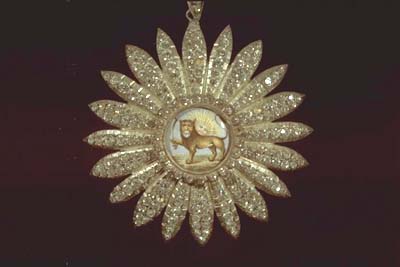 Qajar (Kadjar) Orders and Decorations
Qajar (Kadjar) Orders and Decorations
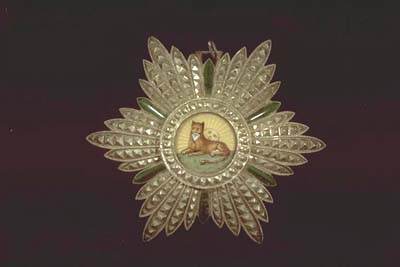
 Qajar (Kadjar) Orders and Decorations
Qajar (Kadjar) Orders and Decorations

The Qajars (Kadjars) devised and introduced a distinct series of orders and decorations, inspired by Ottoman and Western examples, worn by the rulers themselves and given by the rulers to their loyal subjects who had distinguished themselves in the service of the country and their monarch.(*) The wearing of medals became de rigueur among nobles and notables who competed amongst themselves for the award of such decorations. Decorations were also, in many cases, accompanied by titles, for which the Qajar (Kadjar) period is distinctly known. Thus the competition for titles granted by the shah and the decorations that went with them, and the wearing of those decorations at official occasions became a major sign of distinction among nobles and notables of the Qajar (Kadjar) period. Sometimes the competition for decorations even affected the monarch himself, as the case of the Garter, during Mozaffar-ed-Din Shah's visit to England, well illustrates.(#) Yet, this competition for awards of decorations, titles and medals, was not endemic to Qajar (Kadjar) Persia or to Qajar (Kadjar) times. As medals, titles and decorations indicated rank and service to crown and country, they were more or less sought after in all regimes of the period and even after. And it was also not just Persians pining for medals of their own and those of other countries such as the order of the Garter or that of the Grand Cross, but also other nationals pining for the Persian orders and medals such as that of the Lion and the Sun, as the Iranica article points out.
For British writers of the Qajar (Kadjar) era and for writers beholden to the Pahlavis or writing under the influence of the Pahlavi era's effort to simultaneously forget and ridicule the Qajar (Kadjar) period, it became fashionable to poke fun at the profusion of titles, orders and decorations of the Qajar (Kadjar) period. Qajar (Kadjar) titles (of nobility or otherwise) were all made illegal after the ascent of Reza Khan to the throne as Reza Shah Pahlavi. As to Qajar (Kadjar) medals and decorations, however, the Pahlavis substantially incorporated Qajar (Kadjar) era medals and decorations and added to them a few of their own. Still, politics and intrigue aside, Qajar (Kadjar) orders and decorations are a fascinating topic of research, and objects of artistic interest and esthetic appeal, to say nothing of their historic importance.
The Encyclopaedia Iranica states that the practice of awarding honors and decorations was initiated by Fath Ali Shah (r. 1212-50/1797-1834), who introduced the Lion and Sun order (neshaan-e shir o khorshid) in 1223/1808, apparently inspired by the Red Crescent adopted by the Ottoman Sultan Selim III (1203-22/1789-1807). It was bestowed on military men and civilians, both native and foreign.(@)
Nasser-ed-Din Shah (1264-1313/1848-96) increased the repertoire of honors and decorations to include the Temssaal-e Amir-al-Mo'meneen (referring to Imam 'Ali and bearing his image), reserved for the shah exclusively. According to Julian Raby, the Temssaal-e Amir al-Mo'meneen was introduced and instituted in a special ceremony in November 1856, "when a medallion enclosing a miniature portrait of Imam Ali was hung around the Shah's neck, to the accompaniment of a 120-gun salute." The Temssaal-e Amir-al-Mo'meneen was introduced after the recapture of Herat in 1273/1856 by Soltan Morad Mirza, Hessam Saltaneh. The medal was worn by the shah at public ceremonies and national festivals.
In this portrait, the original of which is at the Louvre's Oriental collections, Nasser-ed-Din Shah is wearing the Temssaal-e Amir-al-Mo'meneen and the Lion and Sun decorations (neshaan) as well as the light blue sash reserved for him exclusively. The Lion and Sun decoration on this portrait has twenty two radiating points, and, from all appearances, on it the lion does not hold a sword.
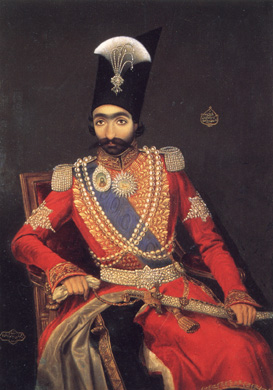
Nasser-ed-Din Shah also introduced the order of Temssaal-e Homaayooni (Imperial Portrait). At first he reserved diamonds for the highest decorations, especially that with the Royal Portrait. Although the Imperial Portrait was already introduced during Fath Ali Shah's reign, it was only in 1848, the first year of Nasser-ed-Din Shah's reign, that the Imperial Portrait was instituted as the highest class of the Order of the Lion and Sun.
Julian Raby states that it was Mohammad Shah who began to wear a miniature portrait of Fath Ali Shah (Temssaal-e Homayooni) as part of the European-style uniform that he was introducing as the new court attire. Nasser-ed-Din Shah continued this practice by wearing a portrait of his father, Mohammad Shah. Below is a portrait of Mohammad Shah from the book Qajar Portraits, wearing European-style dress and said medal. The blue sash is reserved for the shah's use only.
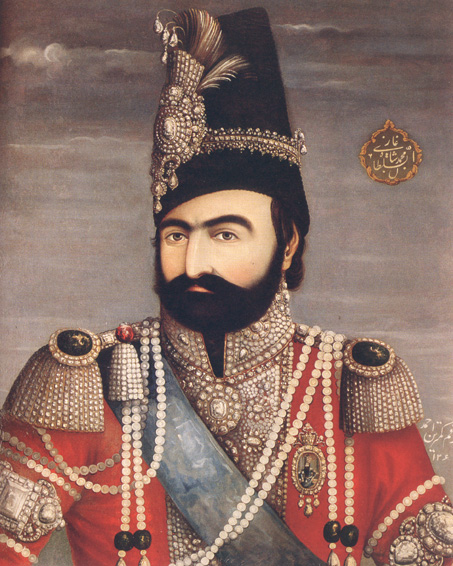
Nasser-ed-Din shah also introduced the Aaftaab (Sun) order for royal women. The Aaftaab order was introduced in 1290/1873 specifically for presentation to queens and princesses, including the empress Augusta of Germany and Queen Victoria, during the shah's European tour in that year. The shah's wife Anis-ed-Dowleh received it on his birthday in 1306/1888. In 1314/1896 Mozaffar-ed-Din Shah (r. 1313-24/1896-1907) awarded it to the wife of the Ottoman ambassador Shams-al-Din Beg. During his reign, decorations were made of silver. Below is a picture of this order from Qajar Portraits.
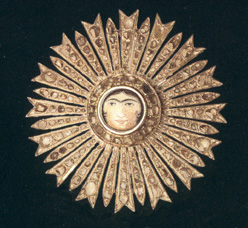
Under Fath-Ali Shah, the Lion and Sun order was composed of a central medallion with eight radiating points framing a lion against a rising sun; it was ornamented with jewels. Crown prince Abbas Mirza issued a similar decoration for military valor; it bore a legend on the obverse and a distich composed for the occasion on the reverse. Here is a picture from Qajar Portraits of the order as it looked under Fath Ali Shah's rule.
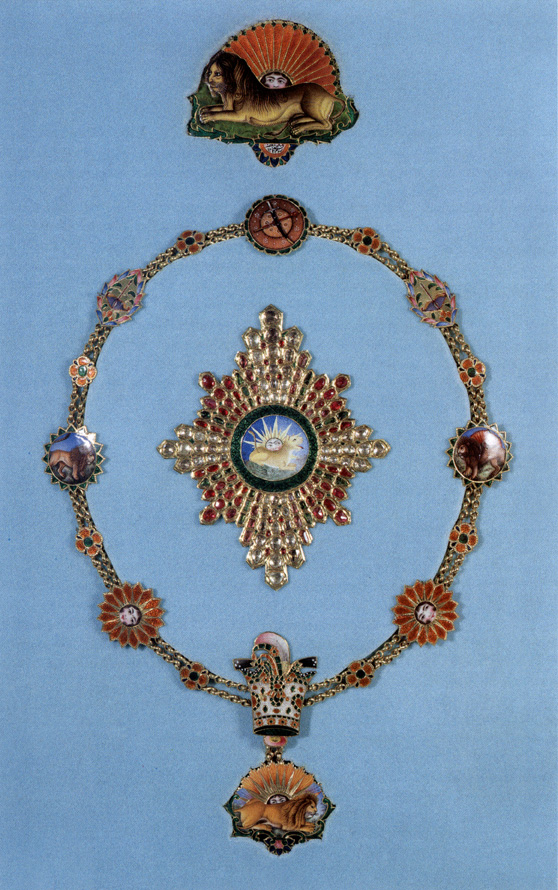
In the following picture, taken at Hatfield House, the residence of Lord Salisbury, on the occasion of Nasser-ed-Din Shah's last visit to England in 1889, Nasser-ed-Din Shah, fully aware of the symbolism and the weight of tradition, is wearing the oldest decoration of his dynasty, the decoration of the Lion and Sun instituted by his great-grandfather Fath' Ali Shah Qajar (Kadjar). It is here as described in the paragraph above.

Under Mohammad Shah (r. 1250-64/1834-48) there were eight classes of the Lion and Sun, corresponding to military rank, from four-star general to non-commissioned officer, each with three grades. Under Nasser-ed-Din Shah the number was raised to nine with the creation of the rank of mir panj (comparable to lieutenant-general)($). The lion was shown holding a raised sword in one paw, and the decoration was set with diamonds.
For civilians, rubies and sapphires replaced the diamonds, and the lion was depicted reclining without the sword. In 1278/1861 Nasser-ed-Din Shah created three new categories of the Lion and Sun, which became the highest decorations during his reign; they were the Aqdas, the Qodseh or Qods, and the Moqaddas. Each consisted of a central medallion set within a twelve-pointed star and bearing the image of the lion and sun, surmounted by a Kiani crown (Tadj-e Kian); each was set with diamonds and rubies. The highest was the Aqdas, reserved for kings and prime ministers; among those who received it was the Ottoman Sultan Abdul-Aziz, in 1280/1863. Ambassadors and dignitaries of comparable status received the Qodseh. The Moqaddas was intended for ministers, governors, and the like. Below is a picture of the Aqdas Lion and Sun order from Qajar Portraits.
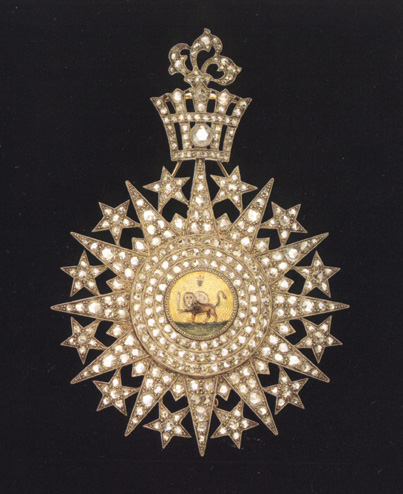
In 1289/1872 court minister Mirza Hossein Khan Moshir-ed-Dowleh Sepahsalar established five classes of the Lion and Sun for foreigners and Persian civil servants, on the pattern of the French Legion d'honneur. From then on civilians and foreigners no longer received the Moqaddas; those who would previously have been eligible for it received instead the Lion and Sun, first class. The different classes were represented by the number of points in the framing star: from eight for the first class to four for the fifth class.
The Lion and Sun, first class, was parallel to the military Lion and Sun given to three-star generals and was awarded with a green sash. The Imperial Portrait (Homayoun or temssaal-e homayouni) was intended for high-ranking officials and foreign dignitaries. It consisted of an oval medallion 12-14 cm long with the portrait of the shah; it was framed in diamonds, rubies, and sapphires and had a crown at the top. There were three classes of this decoration. Except for the lower classes of the Lion and Sun, all these honors were awarded with the sash (hamaayel). The shah's exclusive sash was light blue. The grand vizier and four-star generals wore plain green; when the vizier was wearing the Imperial Portrait his sash was bordered with dark-blue stripes. Ambassadors generally wore dark blue with the Royal Portrait, and a darker blue with the first class of the Lion and Sun. The commander-in-chief of the armed forces (sardar sepah) wore a blue sash bordered with green stripes. Three-star generals wore red with green border stripes and two-star generals red with white border stripes. Brigadier generals wore plain red, and colonels plain white. These sashes could also be awarded separately. The eighth and ninth classes of the Lion and Sun for military personnel were considered medals.
Here is a picture of the Imperial Portrait medallion with Nasser-ed-Din Shah's likeness from this period:
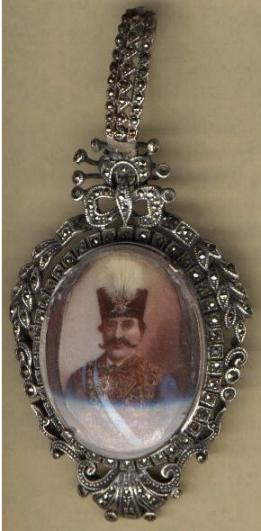
(Source: private collector)
In 1269/1852, Nasser-ed-Din Shah's Polytechnic school, the Daar ol-Fonoun, founded by Amir Kabir, began awarding gold, silver, and copper medals bearing the image of the Lion and Sun to outstanding students. The Madresse-ye Naasseri and Madresse-ye Nezaam-e Dowlati (Military School) also granted medals. Later this system was replaced by the Elmi (Science or Scientific) medal, with three classes, for the dissemination and advancement of knowledge; it was bestowed upon students, teachers, university professors, writers, and scientists, both Persian and foreign. From the later half of Nasser-ed-Din Shah's reign to the end of the Qajar (Kadjar) period, the Lion and Sun and the Imperial Portrait underwent a kind of "inflation," being awarded with increasing frequency. The Lion and Sun for foreigners became particularly known in Russia, to the point that in the last decade of the 19th century Anton Chekhov satirized the eagerness of his countrymen to possess it! (!)
Below are four examples of Lion and Sun medallions from the Qajar (Kadjar) period:
 and
and 
(Photos of above medals courtesy our cousin Ambassador Farhad Sepahbody-Qajar)
 and
and 
(Pictures from www.antiques-mall.com site)
A new system of official honors was instituted by the Pahlavi dynasty, though two Qajar (Kadjar) decorations were continued, with major modifications, from the Qajar (Kadjar) period. The five classes of the Lion and Sun for civilians persisted under the name Homayoun, and the Amir-al-Mo'meniin became the military Zol-faqaar (the name of Imam Ali's sword). The Homayoun was a simplified and modernized version of the original Qajar (Kadjar) Lion and Sun. The badge consisted of a central medallion bearing an enameled disk of the lion with upraised sword and the rising sun with five rays, framed within an eight-pointed star; the star was also superimposed upon a sunburst with eight points; the third class consisted only of the star, without the badge. The first class was worn with a green sash bordered in red stripes, the second class suspended from a red-bordered green ribbon by means of a rosette. There was also a Homayoun medal, with three grades, of gold, silver, and bronze, intended for lower-ranking civil servants, which ceased to be awarded in the last decades of the Pahlavi dynasty.
Here are examples of the Pahlavi Homayoun 1st class medallion and the Pahlavi Homayoun 1st class gold medal respectively:
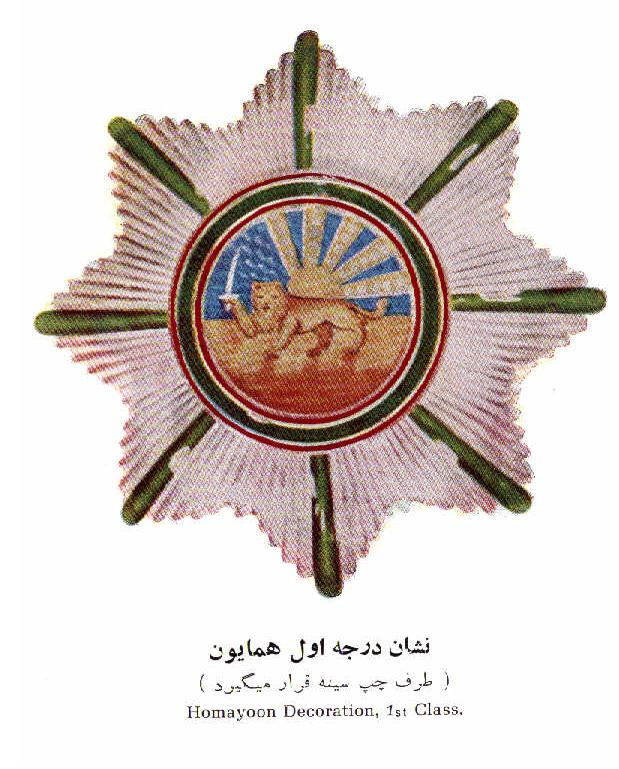 and
and
(Pictures from www.antiques-mall.com site)
The complete Pahlavi neshaan (medal) included the badge, the star, and the sash. Among the new decorations introduced there were three royal honors (neshaanhaa-ye saltanati). The Pahlavi, with two classes, was introduced in 1304/1925-26, as the highest Persian honor. The first class was limited to reigning monarchs and foreign heads of state; the second class was for male members of the royal family and heirs apparent of foreign monarchies.
The other new decorations were intended for women and were introduced under Mohammad-Reza Shah Pahlavi (r. 1320-57/1941-79). The Haft Peykar ("Pleiades," referring to the "Seven Sisters," as the Pleiades are called in Farsi, and among them the star Soraya, also the name of the shah's second wife), with three classes, was adopted in 1336/1957. The Aryamehr, with two classes, was introduced on 4 Mehr 1346/26 September 1967, expressly for Queen Farah to wear during the coronation ceremony. Only she was entitled to wear the first class; the second class was reserved for the shah's sisters, Princesses Shams and Ashraf. Here is an example of the Haft Peykar decoration 2nd class:
(Picture from www.antiques-mall.com site)
The two main Pahlavi civil decorations (neshaanhaa-ye rasmi-e keshvari), the Taj-e Iran and the Homayoun, each with five classes, were instituted on 26 Bahman 1317/15 February 1939 for high-ranking Persian civil servants and foreigners who had performed outstanding service for Persia. The Taj-e Iran, first class, was intended for the prime minister and former prime ministers, and there could be no more than ten people at one time entitled to wear it; the recipient received the title "jenaab" (excellency) and was entitled to a state funeral. One exception was made for Jamshid Amuzegar, minister of finance, who received the decoration in 1350/1971 for his role in oil negotiations and his arrangement of a meeting of the Organization of Petroleum Exporting Countries (OPEC) in Tehran. The second class could be held by only fifty people at one time and the third class by 150. Here are examples of the Pahlavi Homayoun 1st class and the Pahlavi Taj-e Iran 1st class respectively:
 and
and
(Pictures from www.antiques-mall.com site)(%)
Interestingly for the Tadj decoration, the Pahlavis retained the Kiani crown rather than their own Pahlavi crown, and for the Homayoun they retained the Lion and Sun, most associated with the Qajars (Kadjars) because they introduced it on medals and orders first. As with the Qajars (Kadjars) retaining Safavid symbols and even earlier ones to indicate continuity, so also with the Pahlavis, apparently!
By dictating maximum numbers of awards, the Pahlavis tried to limit the proliferation of decorations and medals that occurred during the Qajar (Kadjar) period. In order to limit the proliferation of titles, the Pahlavis limited them to the Royal family itself only, thus abolishing all titles of nobility for all except for themselves. (In particular, Qajar (Kadjar) princes and nobles were not allowed to hold and retain their titles.) One notable exception was made for Prime Minister and Minister of Court Assadollah Alam, who was given the title "Chevalier of the Shah" by Mohammad Reza Shah Pahlavi, for his services to crown and country.
_________________________
Notes:
! The text of Anton Chekhov's story, The Lion and the Sun: A Persian in Russia, was published December 2001 in the online journal The Iranian, to view that page click here.
![]()